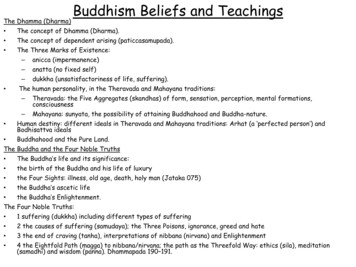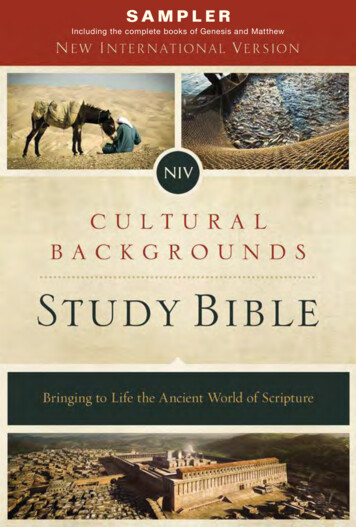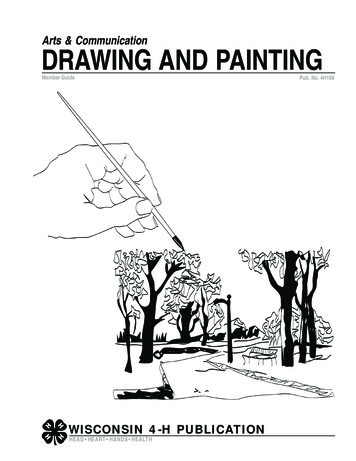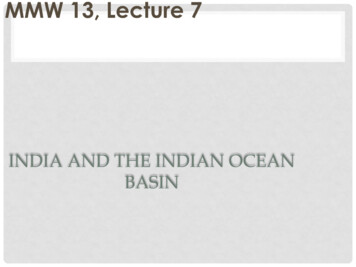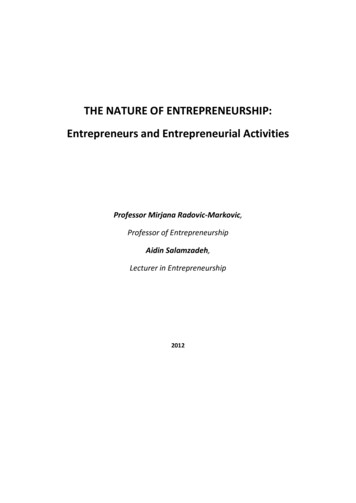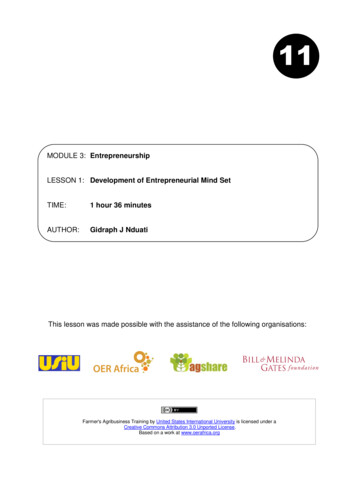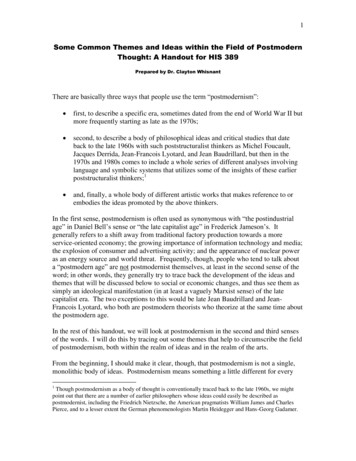
Transcription
1Some Common Themes and Ideas within the Field of PostmodernThought: A Handout for HIS 389Prepared by Dr. Clayton WhisnantThere are basically three ways that people use the term “postmodernism”: first, to describe a specific era, sometimes dated from the end of World War II butmore frequently starting as late as the 1970s; second, to describe a body of philosophical ideas and critical studies that dateback to the late 1960s with such poststructuralist thinkers as Michel Foucault,Jacques Derrida, Jean-Francois Lyotard, and Jean Baudrillard, but then in the1970s and 1980s comes to include a whole series of different analyses involvinglanguage and symbolic systems that utilizes some of the insights of these earlierpoststructuralist thinkers;1 and, finally, a whole body of different artistic works that makes reference to orembodies the ideas promoted by the above thinkers.In the first sense, postmodernism is often used as synonymous with “the postindustrialage” in Daniel Bell’s sense or “the late capitalist age” in Frederick Jameson’s. Itgenerally refers to a shift away from traditional factory production towards a moreservice-oriented economy; the growing importance of information technology and media;the explosion of consumer and advertising activity; and the appearance of nuclear poweras an energy source and world threat. Frequently, though, people who tend to talk abouta “postmodern age” are not postmodernist themselves, at least in the second sense of theword; in other words, they generally try to trace back the development of the ideas andthemes that will be discussed below to social or economic changes, and thus see them assimply an ideological manifestation (in at least a vaguely Marxist sense) of the latecapitalist era. The two exceptions to this would be late Jean Baudrillard and JeanFrancois Lyotard, who both are postmodern theorists who theorize at the same time aboutthe postmodern age.In the rest of this handout, we will look at postmodernism in the second and third sensesof the words. I will do this by tracing out some themes that help to circumscribe the fieldof postmodernism, both within the realm of ideas and in the realm of the arts.From the beginning, I should make it clear, though, that postmodernism is not a single,monolithic body of ideas. Postmodernism means something a little different for every1Though postmodernism as a body of thought is conventionally traced back to the late 1960s, we mightpoint out that there are a number of earlier philosophers whose ideas could easily be described aspostmodernist, including the Friedrich Nietzsche, the American pragmatists William James and CharlesPierce, and to a lesser extent the German phenomenologists Martin Heidegger and Hans-Georg Gadamer.
2area of the arts or every specific field of knowledge that we look at. Still, there are somethemes and ideas common to many of these areas that can serve as “familycharacteristics” (in Wittgenstein’s sense), that is as kinds of interlocking set ofsimilarities that allow us to identify the field in a vague way, but without necessarilydefining it in any definitive way.1. The rejection of ultimate sources of meaning and truth. Many philosophers andliterary theorists of the twentieth century have come to doubt that meaning and truth canbe traced to any ultimate sources, whether this is “reality” in a material/naturalistic senseor an internal subject/ego in a Freudian or phenomenological sense. Truth is eitherinterpreted as a kind of effect of larger systems of knowledge and language (or discourse,as it more commonly is called) or it is interpreted in a pragmatic sense as what simplyworks at any particular moment. In both cases, knowledge is seen as a system (or morecommonly a set of systems) that are free-floating—they have no foundation, nocorrespondence with any absolute reality.2. The death of “depth models” and the embrace of “the surface.” Since manypostmodernists2 have rejected ultimate sources of truth, they also have thrown out the“depth models” that have previously structured most Westernist thought: Plato’s essencesvs. reality, science’s objective knowledge vs. opinion; Kant’s noumenon vs.phenomenon; Marxism’s base vs. ideological superstructure; Freud’s id vs. ego; and eventhe existentialists authentic vs. inauthentic existence. Postmodernists generally argue that“the surface,” “mere appearances” is all there is, or at the very least the only thing thatcounts. Meanings are then generated on the surface level of language that come to createan illusion of depth, when there really is none.In architecture, postmodernism has also involved a return to “the surface,” but in this caseby embracing ornamentation which the modernist school had generally rejected as garish,distracting, unnecessary, and ultimately unenlightened. This does not mean, though, thatpostmodern architecture simply embraces older system of ornamentation (baroque,nineteenth-century historicism, etc); instead, ornamentation has been combined with thetechniques of pastiche (discussed bellows) to draw together different system ofornamentation, frequently in conjuncture with elements of modernism (or at leastelements that remind one of modernism) to create fun, playful, and ideally more livablestructures.3. Play. Because postmodernism generally rejects the depth models of reality, as well asthe metanarratives (discussed below), a lot of the seriousness previously associated withdifferent versions of modernism has also been jettisoned. The result is thatpostmodernism in many different areas has tended to be drawn to the notion of play: theplay of meanings, the play of images, the play of language, the play of structural forms.Postmodernists generally aren’t out to promote any wholesale world reconstructions or to2I should note that I use the term “postmodernist” loosely here to apply to anyone who might be locatedwith the field of philosophical, critical, and artistic activity that has been called “postmodern.” Many ofthese individuals would not have identified themselves as postmodernist, and in fact rejected the term.
3demand horrible human sacrifice towards building a better world, and so there is oftensome room to have fun. The only “big battle” that will make postmodernists very seriousis the reoccurring motif of fighting against the systems of domination and oppressioncaught up with some of the big systems of knowledge that dominate our world (“truth,”the metanarratives, “high art,” etc.). But even here, it is suggested that play can workagainst systems of domination, insofar as it can involve taking advantage of ambiguitieswithin the system (a so-called “play on meaning”) to then erode the system; it can alsomean using elements of the system outside of their intended uses (what Claude LeviStrauss called bricolage, and which was partially modeled on the way kids will take potsand pans and play with them as drums, or take other articles of life and use them withintheir own imaginative play worlds).3. Language is not something that reveals, but constructs. We have a nasty habit ofseeing language as a kind of lens through which we see the internal thoughts of others;through stories told by people, he have some notion that we can actually reach out to pasttimes to see how they “really” were. All this is an illusion, however. In postmodernistterms, language is not transparent; we cannot see through it. Instead, language works alittle bit perhaps like a view-finder (you know, the kids’ toy). It constructs the illusion ofbeing a view into another world, but in fact there is nothing beyond the language.Language works at a very basic level to construct meaning for us; and, in turn, we uselanguage to construct the reality around us.Many different fields have been influenced at one level or another by “the linguistic turn”of the early 1980s. This refers to the new attention paid in many fields (usually of thesocial sciences widely understood—history, sociology, anthropology, political science,theology) to how meaning is constructed within language (or within other symbolicsystems, for example rituals, images, architectural styles, etc.), and therefore howlanguage and other symbolic systems shape our perceptions, values, thoughts, and evenour very lived experiences. In many fields of the social sciences, this was a radical turnaway from a series of different methods, often labeled as “modernist” in retrospect,which tried to ascertain “the reality” behind the human perceptions that were consideredmore fundamental than simply what humans thought about that reality; indeed, manysocial scientists believed that the reality at some level determined human perceptions in avery linear, cause-effect kind of way, but often in a way that human were quiet unawareof. The linguistic turn, then, was an attempt to take what people have to say seriously—to let people speak to us, even if we recognize that that this communication is alwaysgoing to be problematic, always going to be a matter of some interpretation.4. Narratives and Metanarratives. With the new attention to language came a focus onnarratives—that is, the stories that people tell to try to make sense of the world. We havecome to appreciate that stories play a multitude of roles within human life: they allow usto string together meaning, make connections, draw distinctions, construct a sense of whowe are, differentiate us from others, shape and maintain memories, draw maps ofdifferential social status and power, provide ultimate meaning to the world, and many,many more. Indeed, one philosopher, Daniel Dennett (who is not a postmodernist, by the
4way, but who has engaged himself somewhat with postmodernist ideas) suggests that ourminds can be seen as vast, complex, story-writing machines.Narratives do not have equal value. Most of us unconsciously choose some reallyenormous stories that we accept both as “true,” insofar as we then make a multitude ofdecisions in relation to them, and as foundational, insofar as they provide a kind ofbackground story to all the other stories that we tell about our lives. The metanarratives,as they are generally called, are the “big stories” that allow us to make ultimate sense ofthe world: Christianity’s story of sin and redemption; the Enlightenment’s story of theprogress of history towards absolute knowledge; Marx’s story about the dialectic ofhistory that will eventual yield equality, social harmony, and truth; America’s belief inthe eventual triumph of freedom and democracy throughout the world.The problem with metanarratives is that they are so important to us that we tend to try tomake others fit into them—whether they like it or not. And so they are often used tojustify systems of domination and control. Metanarratives almost always insist on somebasic view of “reality” against which truth can be judged; they also have some sense of aproper world order, against which moral action can be judged. Postmodernists points outthat both of these aspects of metanarratives are illusory, and furthermore tend to be usedfor purpose of oppression. And so many postmodernist have tried to debunk thesemetarratives as just what they are—big stories, fictions, even myths.5. The inherent instability of meaning. If “truth” has no relationship to any stablesource (reality or the subject), then meaning is inherently instable, constantly changingdepending on the context (as either its relative usefulness wears off or because of thesystems of language which provide an interpretive framework for the meaning changes.)Postmodern art often makes it a point of demonstrating in an obvious way the instabilityof meaning. This is most frequently done by assaulting or playing with the standard,traditional categories that we use to understand the world. Much postmodern art breaksdown traditional ways of practicing art; a classic example is performance art, which itselfwas originally a radical mixture of dance, visual arts, music, and many other artisticelements in ways that people had a hard time identifying, or understanding in any easyway. Then there are postmodern films that play with genres by combining them insurprising or jarring ways, or perhaps playing with some of the conventions of the genrein a very self-conscious way. Or, it questions the very meaning of what art is. Dada issometimes considered an early version, or perhaps a kind of forerunner, of postmodernart by breaking down the divisions between art and non-art. Some of John Cage’s musichas postmodern elements insofar as here too there is an attempt to question ourassumptions about what art can be.36. The Death of the Author/Artist. One victim of the death of “depth models” is thecreator/genius/author/artist figure that comes down to us from the Renaissance and wasgiven a new spin during the Romantic period. According to this older view, the art is the3John Cage also introduced elements of chance into some of his later pieces as a way of taking the artistout of the artistic process. This, in a way, can be seen as expression of the “death of the artist.”
5expression of a deep soul, whose anguish, or passion, or love, or at the very least powerof creativity, is simply communicated and given evidence to by the work of art. Thisinterpretation tends to prioritize the intentions of the artist over all. Postmodernists,though, would suggest that, first, the ultimate meaning intended by the author can neverreally by known, since that presupposes the existence of a kind of “internal truth of theartist” which simply does not exist. Second, though, the author’s intentions wouldn’tmatter, even if they could be discovered. Once the work of art is created, it becomes aproduct for all of us to interpret in our own way. The artist’s interpretation of his/herown work should not necessarily take priority over anyone else interpretations. Allinterpretations are by nature equally valid, at some level, since there is no “ultimate truth”to compare interpretation by.Some postmodernist artists have taken this insight into how the audience constructs itsown meaning of the work of art to expose the meaning-making process and to generallyself-consciously allow for a multitude of interpretations, instead of trying to cut ofalternative readings, as many realist novels of the nineteenth-century as well as otherforms of art have done. This is often achieved by introducing non-linear elements to thefilm and then letting the audience make its own story out of the various elements (forexample, in the film Pulp Fiction).4 Other postmodern works will include seeminglyrandom elements in the film (for example, in many David Lynch’s films) that allow for aopen range of interpretations, without necessarily prejudicing the audience in favor ofone interpretation or another.7. Intertextuality. If “truth” is not stable, then we need to pay close attention to the waythat specific meanings are generated, and in particular the ways that any given readerdoes make meaning out of a specific text (which could be a film, a piece of art, a novel,etc.). Since context is key to interpreting any given work, specific textual readers will goout first to the various systems of meanings available to them through their memory andexperience. Frequently, this will include other texts (stories that they have heard, filmsthat they have seen at some point, books that they have read) that will help them to makemeanings out of the text in front of them. In other words, they will draw associationsbetween the new object and past objects they have encountered that will in effect set upnetworks of relationships and meanings between the texts. This is what is known as the“intertext,” a kind of virtual text created by the reader at any moment of interpretationthat allows for a connection between a new text and old ones.The notion of intertextuality has been very important for Literature studies, where themodernists of the 1950s (known as the New Criticism) argued that the meaning of a workcould be found solely within the work itself. The author had a single intention when hewrote the work, and ultimately that meaning was locked up, perhaps even as a kind of4This is not quite the same as “stream-of-consciousness”—a modernist technique developed by JamesJoyce and others that at best opened up the possibility of the non-linearity of postmodernist art. The idea ofstream-of-consciousness was that it was the “true” expression of a certain phenomenological reality, that isthe inner experience of the main character. This presupposes a subject, an internalized ego, which we haveseen is also radically questioned by the postmodernist. Postmodernist works of art, in contrast, will suggestnot simply the non-linearity of subjective experience, but of “objective experience” and “real life” itself.
6“secret code” waiting to be discovered, within the text itself. What was needed then wasa “close reading” of the text, a tight analysis of language, symbolism, organization topick up hidden subtleties that could be found, again, solely within the text itself. And inthe end, there would be one meaning, and one meaning only that could be found withinthe text.In contrast, the work of deconstruction has shown that the meaning of text can never becontained within the text itself; it always escapes the borders of the story, while at thesame time working against itself until the artificiality and arbitrariness of the constructedmeaning finally becomes painfully obvious. And then other kinds of literary critics haveshown how the meanings of the work are ultimately constructed by the readersthemselves, who always bring their own set of assumptions, preconceptions, background,values, and interpretive framework. This serves to create multiple interpretations of thetext, none of which are necessarily superior to any other.8. The effacement of the boundary between high culture and low (or mass) culture.If there is no ultimate source of truth, the distinction between high culture and low culturetends to disappear. There have been many ways that the West has tended to validate highculture while denigrating popular or mass culture: high culture is the authentic expressionof a deep soul, while low culture is mere entertainment; high culture requires some realthought, while low culture is for mere pleasure; high culture is “serious,” while lowculture is light fluff. All of this tends to break down within a postmodernist framework.Many postmodernists have attempted to suggest that underlying power implications ofmaking the distinctions between high and low culture. Most commonly, the divisionbetween high culture and low culture has been seen as serving powerful social purposes:as a kind of justification for bourgeois style and a validation of the knowledge held bycertain educated elites. The sociologists Bourdieu has suggested that high culturerequires a certain degree “cultural capital” (which means a kind of education andupbringing) in order to be able to appreciate it. Our society, then, has designed ways ofturning “cultural capital” into “economic capital,” and vice versa. So, in short, thedistinction between high and low culture tends to perpetuate the class distinction.Many postmodern artists, in turn, try to validate popular artistic forms (cartoons, pulpfiction, dance music, pop icon figures—think Andy Warhol), or at the very least to blurthe boundaries between high and low culture (as with the many high-brow referenceswithin any given Simpsons episode).9. Pastiche. From a postmodernist perspective, specific artistic styles (HighRenaissance, Baroque, neo-Classical, etc.) tend to look rather arbitrary. Their coherencehas generally been explained as a kind of “authentic” expression of their era—a creationof a specific Zeitgeist (in a Hegelian sense) or perhaps an expression of the soul of anation (in the sense of the German nationalist Herder). But once we come to doubt thevery notion of authenticity, a specific style comes to be seen as a kind of arbitrary systemof specific shapes, forms, symbols, and other artistic elements that look “natural” or“right” to us simply because we have grown up with them and learned to appreciate their
7internal networks of meaning. But there is no “natural” reason that this system ofmeanings has to be maintained. Indeed, whole new systems of meaning can be createdby taking different elements from different styles in putting them together in productiveways. This could be freeing, and indeed more original than forcing yourself to live byspecific artistic conventions10. The exposure of “the Canon.” The Canon refers to that set of works that everyacademic field (and indeed, culture at large) has which are set apart as special, unique,“classic,” and therefore necessary knowledge for anyone who wants to carry out work inthe academic field (or perhaps simply wants to be known as a cultured person). Theobvious example in English is Shakespeare, which is required background knowledge forthose who want to study English literature, but in general is thought to be requiredbackground for anyone who wants to call themselves educated.Many critics in the postmodern era have set about trying to expose the Canon as anarbitrary list of books, the works in which have been selected to promote powerful social,racial, or gender interests. There are many ways to do this: you could showsystematically how works by women, or African-Americans have been excluded. Youcould examine the works themselves to show how the meanings within the work createpowerful prejudices against these different social groups. You could provide alternatereadings to the “classic” works which subvert the dominant readings of the text. Andthen, an interesting way has been chosen by Shakespeare scholars who havedemonstrated the way that Shakespeare’s works themselves are a kind of pastiche takenfrom different high-culture and low-culture sources.11. Art that exposes the artifice of art. Traditionally, much art in the Western worldwas supposed to a kind of illusion, yet one that we came to believe in. The more flawlessthe illusion, the better the work of art. Novels opened up an imaginary world, filled withalmost real people, who had seemingly real feelings, and then brought us throughexperiences that were both extraordinary, and yet still somehow convincing. Statueswere supposed to mimic the human or animal form, or at the very least reveal somethingessential about human nature or the human experience of living. More recently, mostcontemporary rock ‘n’ roll albums create an illusion of the real band playing in front ofyour eyes (and ears), while concealing the process that goes into creating that illusion(the multitrack nature of recording, where every player records separately and often manytimes before the final composition can be created out of elements of the best recordings).Much modern art directly rejected the referential nature of art by fragmenting it intopieces (Cubism) or by turning toward abstract expressions. Postmodern art, on the otherhand, does not simply reject the referential nature of art; it does its best to actually exposehow the illusion-making process works. It retains obvious contradictions, or it mightopen up gaps within the illusory world so that the illusion might be revealed as hollow.Films, plays, and novels might be self-referential; in other words, they might make offhanded or ironic comments that pulls the audience out of the illusion and forces theaudience to confront the work as a kind of construction (a technique used often in the
8Simpsons, but also in any film where the actor/ess looks out at or even talks to theaudience as if he/she knows that there is an audience out there watching).12. The inevitability and productivity of tension, confusion, contradiction, andambiguity. Postmodernism has come to see tension, confusion, contradiction, andambiguity as an inevitable product of the multiple levels of systems of knowledge andnarratives circulating at one time. And where little ambiguity or confusion exists, thepostmodernist is generally very suspicious, since we have to suspect that there arepowerful forces at working creating coherence that is making everything and everyoneconform. And so, whereas a modernist often would have seen confusion as a sign offaulty knowledge or the lack of knowledge, contradiction as a problem yet to be workedout, and finally ambiguity as simply a lack of clarity or perhaps a unfortunatemisunderstanding, postmodernists generally look for these elements as the inevitableproduct of living within systems of meaning. Indeed, these aspects can be extremelycreative, since they can cause new systems of meaning to be generated, and cansometimes allow us to free ourselves (at least in a small way) from the webs of discourseand meaning that circumscribe our particular circumstance by giving us a range ofmeanings to choose from.13. Liberation. Although postmodernism is sometimes accused by outsiders ofpromoting authoritarian or totalitarian tendencies, actually most postmodernists believethey are working towards a kind of liberation—liberation from the totalitarian tendenciesof reason that have been discussed by the German sociologists Max Weber and MaxHorkheimer (not themselves postmodernists, but very influential on the postmodernists);liberation from the government and social power structures that try to create coherencewithin the world; and last, liberation from the historical tendencies that tend to shut downchange and therefore exclude future developments. Now, admittedly, the notion ofliberation is always problematic from a postmodernist perspective. Liberation is one thatcan only be defined from within the system, and so in some sense is already limited bythe system; furthermore, “liberation” from the system has a tendency to generatemeanings and systems of practice that in the long run becomes the rules that bind futuregenerations. Still, most postmodernists are not simple determinists, suggesting that wecan only act in a predictable way according to the system of meaning in which we live.Although we tend to, ambiguities and contradictions within the systems open up a certainspace for individual action; the result is the possibility for spontaneity, unpredictability,and in the end something which maybe could be identified as “freedom,” so long as weunderstand the limitations of this term. 2012 Clayton J. Whisnant. All Rights ReservedCitation: Clayton J. Whisnant, “Some Common Themes and Ideas within the Field ofPostmodern Thought: A Handout for HIS 389,” last modified November 19, tmodernism.pdf
Nov 19, 2013 · 3. Play. Because postmodernism generally rejects the depth models of reality, as well as the metanarratives (discussed below), a lot of the seriousness previously associated with different versions of modernism has also been jettisoned. The result is that postmodernism in many differen
